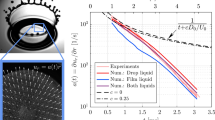Abstract
The strain-rate dependent tensile response of a transparent elastomer, polyurea, is determined at stretch-rates in the range of 800 to 8000 per second. This is accomplished by measuring the spatio-temporal evolution of the particle velocity and strain in a thin strip subjected to high speed impact loading that generates uniaxial stress conditions. The observed response is modeled using a modified viscoplastic constitutive relation.












Similar content being viewed by others
Notes
In fact, there is never a truly linear region from which a proper elastic modulus can be extracted.
In some later tests, the specimen was glued to the slider to prevent slippage.
The transparency was influenced significantly by the mixing procedure; when the Versalink and Isonate were not mixed adequately, it resulted in an opaque, stiff polymer with a very small stretch to failure. By ensuring proper mixing with a stirrer, it was possible to obtain specimens that were transparent yellow in color.
See the Supplementary Material of Niemczura and Ravi-Chandar, [15] for a video of the propagation of nonlinear elastic waves in a polyisoprene rubber. The wave propagation observed in the polyurea appears to be very similar.
It should be noted that these plots result from taking derivatives of the position data; therefore there is an inherent error from numerical differentiation that has been smoothed by a moving average filter. Furthermore, the slider interacts frictionally with the guiding slots in the barrel and provides a nonuniform boundary condition at the attachment point.
We have introduced a constant k in an effort to allow more flexibility in calibrating the measured response. The physical meaning of this is that the equilibrium response is somewhat stiffer than the quasi-static response. In this matter, we can only present a heuristic argument, since a detailed micromechanical model is not available. We suppose that the quasistatic response is attained only at extremely slow rates, when all possible configurations of the polymer chains can be sampled; in contrast, under the high strain-rate loading employed here, we conjecture that only some fraction of the possible configurations are sampled, naturally leading to a stiffer response.
References
Mathews W (2004) Services test spray-on vehicle armor, Army Times, May 3, 2004
Barsoum RGS, Dudt PJ (2009) The fascinating behaviors of ordinary materials under dynamic conditions. AMMTIAC Q 4:11–14
Patel P, Gilde GA, Dehmer PG, McCauley JW (2000) Transparent armor. AMPTIAC Newsl 4:1–9
Shockey D, Bergmannshoff D, Curran DR (2008) Failure Physics of Glass during Ballistic Penetration, presentation at the 32nd International Conference & Exposition on Advanced Ceramics & Composites, January 27-February 1, 2008, Daytona Beach, FL
Strassburger E (2009) Ballistic testing of transparent armour ceramics. J Eur Ceram Soc 29:267–273
Bless S, Chen T (2010) Impact damage in layered glass. Int J Fract 162:151–158
Subhash G, Ravichandran G (2000) Split Hopkinson Pressure Bar Testing of Ceramics, ASM Handbook, Mechanical Testing and Evaluation, Volume 8, ASM International, 497–504
Youssef G, Gupta V (2011) Dynamic Response of Polyurea subjected to nanosecond rise-time stress waves. Mech Time Dependent Mater. doi:10.1007/s11043-011-9164-7
Roland CM, Twigg JN, Vu Y, Mott PH (2007) High strain rate mechanical behavior of polyurea. Polymer 48:574–578
Chakkarapani V, Ravi-Chandar K, Liechti KM (2006) Characterization of multiaxial constitutive properties of rubbery elastomers. J Eng Mater Technol Trans ASME 128:489–494
Amirkhizi AV, Isaacs J, McGee J, Nemat-Nasser S (2006) An experimentally-based viscoelastic constitutive model for polyurea, including pressure and temperature effects. Philos Mag 86:5847–5866
Zhao J, Knauss WG, Ravichandran G (2007) Applicability of the time-temperature superposition principle in modeling dynamic response of a polyurea. Mech Time Dependent Mater 11:289–308
Qiao J, Amirkhizi AV, Schaaf K, Nemat-Nasser S, Wu G (2011) Dynamic mechanical and ultrasonic properties of polyurea. Mech Mater 43:598–607
von Karman T, Duwez P (1950) The propagation of plastic deformation in solids. J Appl Phys 21:987–994
Niemczura J, Ravi-Chandar K (2011) On the response of rubbers at high strain rates: I: simple waves. J Mech Phys Solids 59:423–442
Malvern LE (1951) Plastic wave propagation in a bar of material exhibitinig a strain-rate effect. Q Appl Math 8:405
Johnson GR, Cook WH (1985) Fracture characteristics of three metals subject to various strains, strain rates, temperatures and pressures. Eng Fract Mech 21:31–48
Bergstrom JS, Boyce MC (1998) Constitutive modeling of the large strain time-dependent behavior of elastomers. J Mech Phys Solids 46:931–954
Zhou M, Clifton RJ (1996) Dynamic ductile rupture under conditions of plane strain. Int J Impact Eng 19:189–206
Zhang H, Liechti KM, Ravi-Chandar K (2009) On the dynamics of necking and fragmentation: III. Effect of cladding with a polymer. Int J Fract 155:101–118
Acknowledgments
This work was performed under a program entitled “Dynamic Response of Metal-Polymer Bilayers - Viscoelasticity, Adhesion and Failure” sponsored by the Office of Naval Research (ONR Grant Number N00014-09-1-0541, Program Manager: Dr. Roshdy Barsoum); this support is gratefully acknowledged.
Author information
Authors and Affiliations
Corresponding author
Rights and permissions
About this article
Cite this article
Albrecht, A.B., Liechti, K.M. & Ravi-Chandar, K. Characterization of the Transient Response of Polyurea. Exp Mech 53, 113–122 (2013). https://doi.org/10.1007/s11340-012-9663-8
Received:
Accepted:
Published:
Issue Date:
DOI: https://doi.org/10.1007/s11340-012-9663-8




